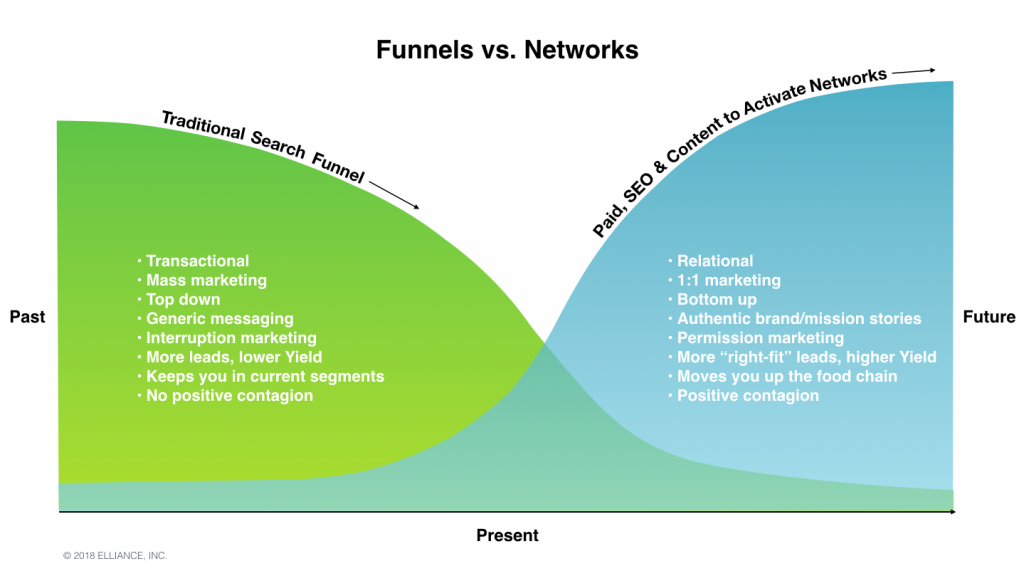| Mar 31, 2018
College Student Search Campaigns – Evolution From Funnels to Networks
Every year, a silent, high-stakes dance takes place in all the 4,000+ colleges and universities in the US. To meet their enrollment targets, the colleges look for the best-possible group of students who will apply, and then accept the offers extended to them.
Lead generation with College Student Search is the first step in this ritual dance with a singular objective: to generate an initial list of best-fit, most-likely-to-apply-and-subsequently-accept high school students.
Like everything else in enrollment management, digital has disrupted the traditional College Student Search:
Traditional College Student Search Campaigns – Buy A Large Set of Names and Whittle The List Down
This was the textbook strategy for student search. Enrollment professionals bought tens of thousands of prospective student names from various sources – at a price ranging from 20 to 40 cents per name. Then they sent them a series of emails and direct mail pieces with the hope of getting some of them to raise their hands indicating interest in the college.
Most enrollment professionals are still stuck in this antiquated numbers-game strategy i.e. cast out a wide net, see what you catch, and do everything in your power to hang on to as many of them as possible.
After living a long life of three decades, this traditional strategy is about to expire and is being replaced by a new strategy.
College Student Search Campaigns for the Digital Age – Generate Names with An Inverted Funnel, Micro-targeting and 1-to-1 Marketing
In the “Inverted Funnel” strategy, colleges are creating authentic student/alumni/faculty stories on their website and social media channels. Social sharing with friends, friends of friends, and friends of friends of friends results in them raising their hands. This relies on the classic “birds-of-a-feather” approach.
A second element of this is to take advantage of new micro-segmentation and 1-to-1 marketing opportunities that Google, Facebook, LinkedIn, Twitter and other social platforms have started offering in the last two years.
For Facebook, this includes micro-segmentation, look-alike audiences, and lead ads.
For LinkedIn, this includes account targeting, matched audiences and lead-gen forms.
For Google, this includes similar audiences, geo-targeting and variations of local ads.
Why Transition to Digital Student Search
Many colleges are transitioning out of the traditional funnel methods for five simple reasons:
1. Quality: Traditional funnel methods drive “softer” prospect interest and leads and require more support — manpower and financial aid money — for conversion and retention.
2. Fit: Pouring large numbers of prospects into the traditional funnel may allow colleges to become slightly more selective in shaping a class, but rarely taps into deeper “right-fit” connections.
3. Lifetime Value: Along with additional churn that comes with traditional funnel methods, colleges risk diluting “lifetime student value.” That dilution does not reveal itself for a long time — maybe not until those alumni rise to the ranks of future major gift donors.
4. Reach: Compelling brand and mission messages, and digitally targeted content, allows colleges to extend their reach nationally and globally.
5. New Habits: Gen-Z and millennials are now spending most of their time on mobile devices, trusting peer opinions more than the messages coming from marketers.
As one faculty member at one of our clients so eloquently said: “passion and belief in the mission is much more than a line on a resume” (or an enrollment application). Traditional funnel and email campaigns impose a top-down construct that doesn’t invite “right-fit” passion to surface.
The Journey Ahead
Staffing for this digital future will be critical. Key enrollment, advancement, communication and marketing hires will ultimately decide your ability to cross over from a traditional enrollment funnel to a new integrated, digital reality.
If you are seeking enrollment marketing agency to fortify the reputation of your college or university, view our higher education marketing capabilities and consider partnering with us.

